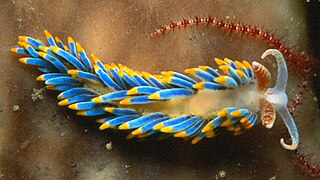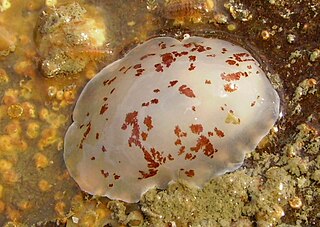
Nudibranchs are a group of soft-bodied marine gastropod molluscs that shed their shells after their larval stage. They are noted for their often extraordinary colours and striking forms, and they have been given colourful nicknames to match, such as "clown", "marigold", "splendid", "dancer", "dragon", and "sea rabbit". Currently, about 3,000 valid species of nudibranchs are known.

The Pleurobranchidae are a taxonomic family of sea slugs, marine gastropod molluscs in the clade Pleurobranchomorpha.

Aeolidia papillosa, known as the common grey sea slug, is a species of nudibranch in the family Aeolidiidae.

Elysia timida is a species of sacoglossan sea slug, a marine opisthobranch gastropod mollusk. Found in the Mediterranean and nearby parts of the Atlantic, it is herbivorous, feeding on various algae in shallow water.

Tylodina perversa, common names the "yellow tylodina" or "yellow umbrella slug", is a species of sea snail or false limpet, a marine opisthobranch gastropod mollusk in the family Tylodinidae.

Berthella ornata is a species of sea slug, a marine gastropod mollusk in the family Pleurobranchidae. It is sometimes called the ornate side-gilled sea slug.

Discodoris boholiensis, known commonly as the Bohol discodoris, is a species of sea slug in the family Discodorididae. It gets its name from the island of Bohol in the Philippines. Discodoris boholiensis has a distinctive pattern of chocolate brown and cream-white all over its flattened body and wavy-edged mantle. It reaches a length of 12 cm (5 in).

Felimida krohni is a species of colorful sea slug, a dorid nudibranch, a marine gastropod mollusc in the family Chromodorididae. This species occurs in European waters and in the Mediterranean Sea (Greece). The specific name krohni was in honour of Russian zoologist August David Krohn.

Berthella martensi is a species of sea slug, a marine gastropod mollusk in the family Pleurobranchidae.

Aeolidiella alderi is a species of sea slug, an aeolid nudibranch in the family Aeolidiidae. It is native to northwestern Europe where it occurs in the intertidal zone. It is a predator and feeds on sea anemones.

Doris pseudoargus is a species of sea slug, a dorid nudibranch, a marine gastropod mollusk in the family Dorididae.

Lamellaria perspicua, commonly known as the transparent lamellaria, is a species of small, slug-like sea snail, a marine gastropod mollusc in the family Velutinidae. It is native to the northeastern Atlantic Ocean and the Mediterranean Sea, where it feeds on colonial ascidians.
Berthella ocellata is a species of sea slug, a marine gastropod mollusc in the family Pleurobranchidae. It is native to the eastern Atlantic Ocean and the Mediterranean Sea where it inhabits the shallow sublittoral zone.
Corticium candelabrum is a species of sponge in the order Homosclerophorida. It is native to the eastern Atlantic Ocean and the Mediterranean Sea where it inhabits the shallow sublittoral zone. The type locality is the Adriatic Sea.

Berthella stellata is a species of sea slug in the family Pleurobranchidae. It is found in shallow water in the Mediterranean Sea, the western Atlantic Ocean and the tropical and subtropical Indo-Pacific region.

Philinopsis speciosa, the blue-lined philinopsis, is a species of sea slug, a shell-less opisthobranch gastropod mollusc in the family Aglajidae. It is native to the Indo-Pacific region.

Tubulophilinopsis gardineri, the Gardiner’s philinopsis, or Gardiner's headshield slug is a species of sea slug, a shell-less opisthobranch gastropod mollusc in the family Aglajidae. It is native to the Indo-Pacific region.

Berthellina edwardsii is a species of sea slug, a gastropod mollusc in the family Pleurobranchidae. It is native to the northeastern Atlantic Ocean and the Mediterranean Sea.
Oscarella tuberculata is a species of sponge in the order Homosclerophorida. It is endemic to the Mediterranean Sea, where it forms encrusting colonies on rocks and other hard surfaces.

Thuridilla vataae is a species of sacoglossan sea slug, a shell-less marine opisthobranch gastropod mollusc in the family Plakobranchidae. It is native to the tropical Indo-Pacific. It was first described by the French zoologist Jean Risbec in 1928; its specific name refers to the Bay of Anse Vata, just south of Nouméa, New Caledonia, where the type specimen was collected.



















